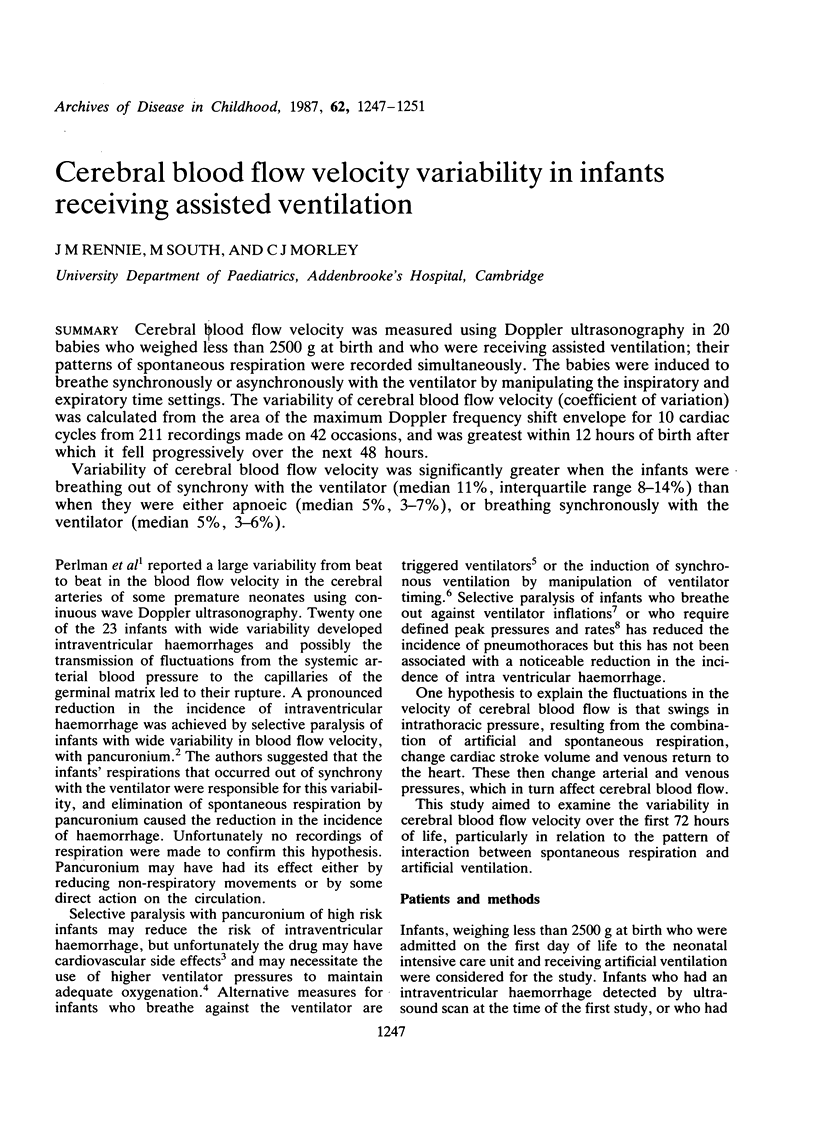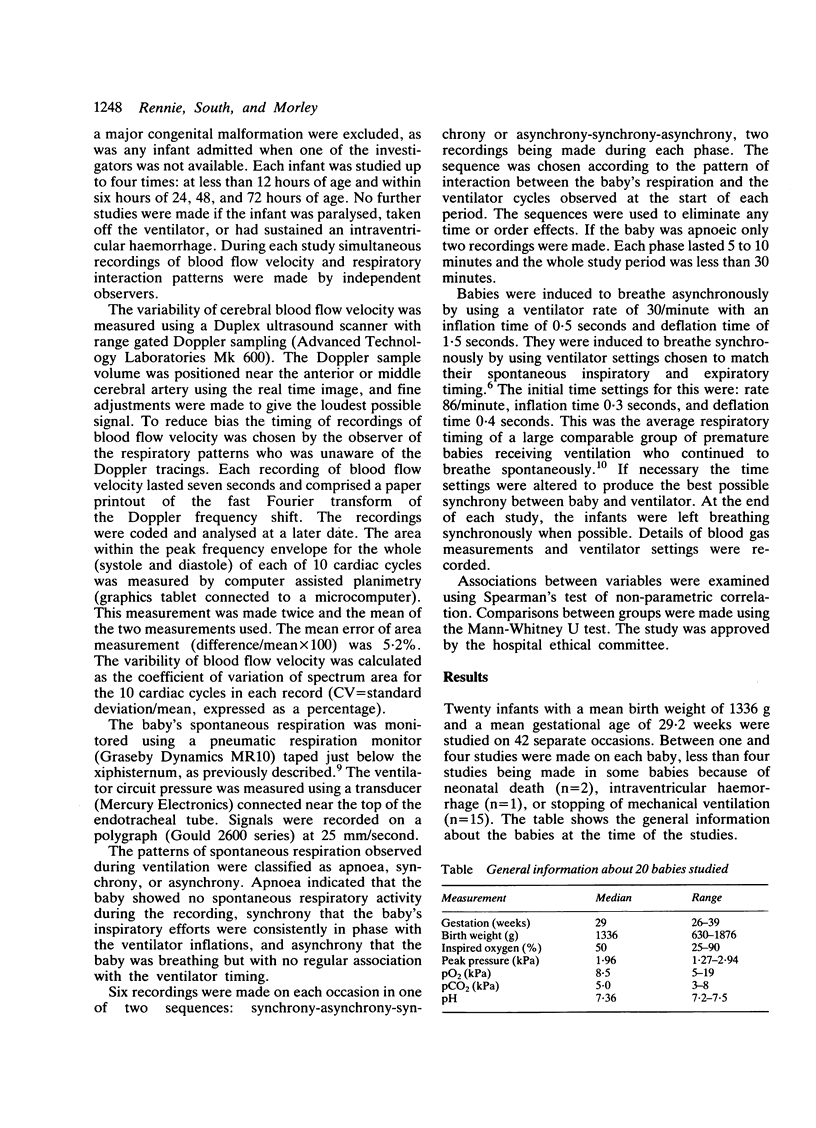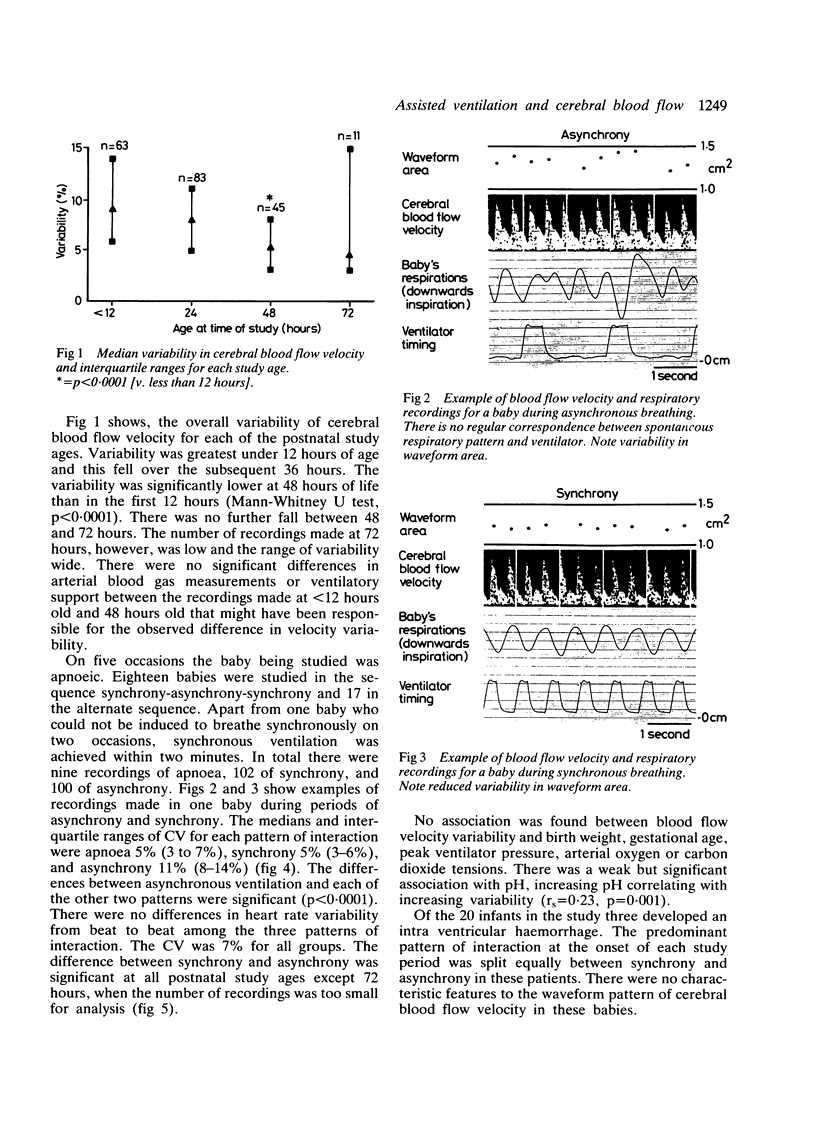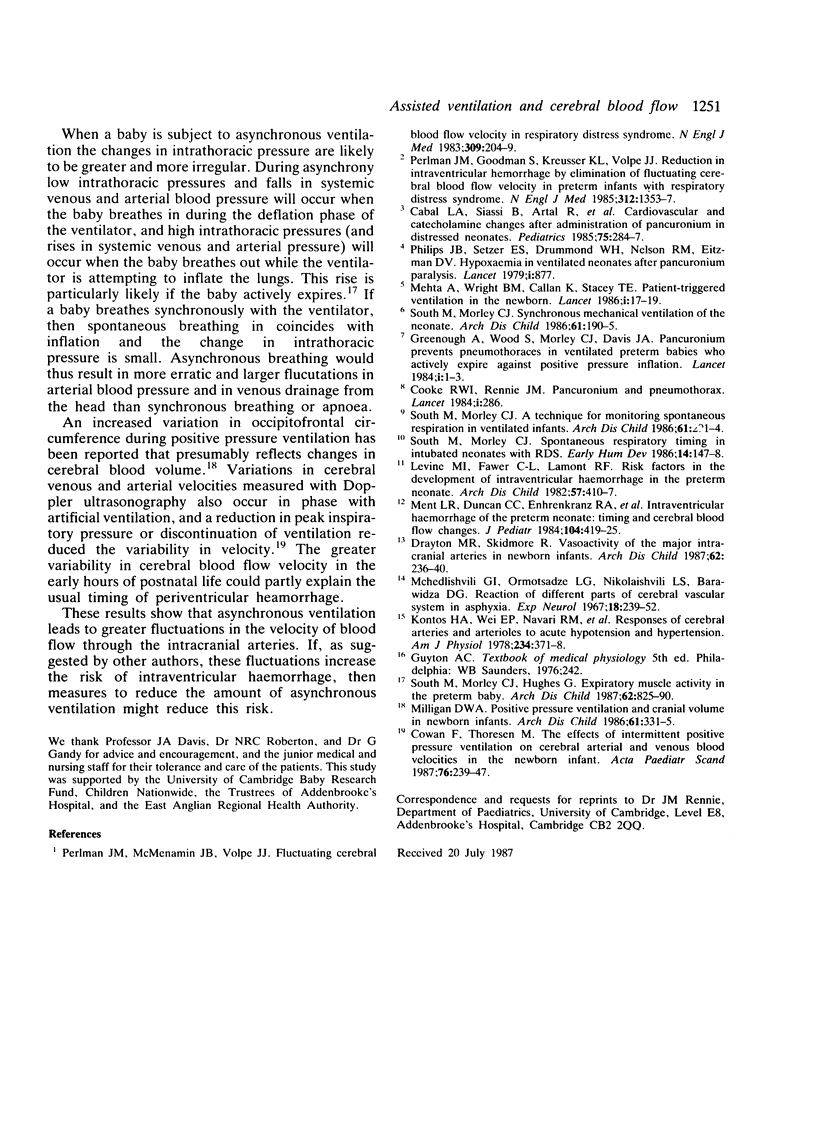Abstract
Cerebral blood flow velocity was measured using Doppler ultrasonography in 20 babies who weighed less than 2500 g at birth and who were receiving assisted ventilation; their patterns of spontaneous respiration were recorded simultaneously. The babies were induced to breathe synchronously or asynchronously with the ventilator by manipulating the inspiratory and expiratory time settings. The variability of cerebral blood flow velocity (coefficient of variation) was calculated from the area of the maximum Doppler frequency shift envelope for 10 cardiac cycles from 211 recordings made on 42 occasions, and was greatest within 12 hours of birth after which it fell progressively over the next 48 hours. Variability of cerebral blood flow velocity was significantly greater when the infants were breathing out of synchrony with the ventilator (median 11%, interquartile range 8-14%) than when they were either apnoeic (median 5%, 3-7%), or breathing synchronously with the ventilator (median 5%, 3-6%).
Full text
PDF




Selected References
These references are in PubMed. This may not be the complete list of references from this article.
- Alberman E., Watson E., Mitchell P., Day S. The development of performance and cost indicators for preschool immunisation. Arch Dis Child. 1986 Mar;61(3):251–256. doi: 10.1136/adc.61.3.251. [DOI] [PMC free article] [PubMed] [Google Scholar]
- Cabal L. A., Siassi B., Artal R., Gonzalez F., Hodgman J., Plajstek C. Cardiovascular and catecholamine changes after administration of pancuronium in distressed neonates. Pediatrics. 1985 Feb;75(2):284–287. [PubMed] [Google Scholar]
- Cowan F., Thoresen M. The effects of intermittent positive pressure ventilation on cerebral arterial and venous blood velocities in the newborn infant. Acta Paediatr Scand. 1987 Mar;76(2):239–247. doi: 10.1111/j.1651-2227.1987.tb10454.x. [DOI] [PubMed] [Google Scholar]
- Drayton M. R., Skidmore R. Vasoactivity of the major intracranial arteries in newborn infants. Arch Dis Child. 1987 Mar;62(3):236–240. doi: 10.1136/adc.62.3.236. [DOI] [PMC free article] [PubMed] [Google Scholar]
- Greenough A., Wood S., Morley C. J., Davis J. A. Pancuronium prevents pneumothoraces in ventilated premature babies who actively expire against positive pressure inflation. Lancet. 1984 Jan 7;1(8367):1–3. doi: 10.1016/s0140-6736(84)90177-6. [DOI] [PubMed] [Google Scholar]
- Levene M. I., Fawer C. L., Lamont R. F. Risk factors in the development of intraventricular haemorrhage in the preterm neonate. Arch Dis Child. 1982 Jun;57(6):410–417. doi: 10.1136/adc.57.6.410. [DOI] [PMC free article] [PubMed] [Google Scholar]
- Mchedlishvili G. I., Ormotsadze L. G., Nikolaishvili L. S., Baramidze D. G. Reaction of different parts of the cerebral vascular system in asphyxia. Exp Neurol. 1967 Jun;18(2):239–252. doi: 10.1016/0014-4886(67)90045-3. [DOI] [PubMed] [Google Scholar]
- Mehta A., Wright B. M., Callan K., Stacey T. E. Patient-triggered ventilation in the newborn. Lancet. 1986 Jul 5;2(8497):17–19. doi: 10.1016/s0140-6736(86)92562-6. [DOI] [PubMed] [Google Scholar]
- Ment L. R., Duncan C. C., Ehrenkranz R. A., Lange R. C., Taylor K. J., Kleinman C. S., Scott D. T., Sivo J., Gettner P. Intraventricular hemorrhage in the preterm neonate: timing and cerebral blood flow changes. J Pediatr. 1984 Mar;104(3):419–425. doi: 10.1016/s0022-3476(84)81109-9. [DOI] [PubMed] [Google Scholar]
- Pancuronium and pneumothorax. Lancet. 1984 Feb 4;1(8371):286–287. [PubMed] [Google Scholar]
- Perlman J. M., Goodman S., Kreusser K. L., Volpe J. J. Reduction in intraventricular hemorrhage by elimination of fluctuating cerebral blood-flow velocity in preterm infants with respiratory distress syndrome. N Engl J Med. 1985 May 23;312(21):1353–1357. doi: 10.1056/NEJM198505233122104. [DOI] [PubMed] [Google Scholar]
- Perlman J. M., McMenamin J. B., Volpe J. J. Fluctuating cerebral blood-flow velocity in respiratory-distress syndrome. Relation to the development of intraventricular hemorrhage. N Engl J Med. 1983 Jul 28;309(4):204–209. doi: 10.1056/NEJM198307283090402. [DOI] [PubMed] [Google Scholar]
- Philips J. B., 3rd, Setzer E. S., Drummond W. H., Nelson R. M., Eitzman D. V. Hypoxaemia in ventilated neonates after pancuronium paralysis. Lancet. 1979 Apr 21;1(8121):877–877. doi: 10.1016/s0140-6736(79)91291-1. [DOI] [PubMed] [Google Scholar]
- South M., Morley C. J., Hughes G. Expiratory muscle activity in preterm babies. Arch Dis Child. 1987 Aug;62(8):825–829. doi: 10.1136/adc.62.8.825. [DOI] [PMC free article] [PubMed] [Google Scholar]


